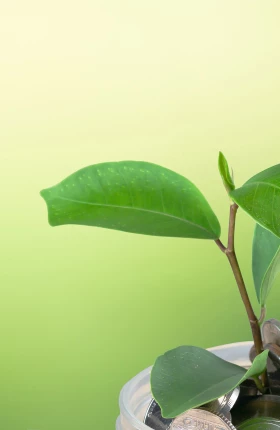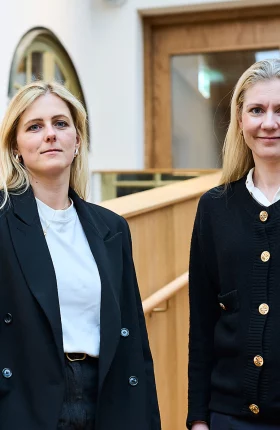When it comes to investing in new green businesses, CEOs tend to have clarity on the “why.” Less understood, though, is the “how.”
The list of reasons why the green economy represents a massive value-creation opportunity is long and well
Furthermore, as the cost of climate inaction becomes increasingly evident amid frequent natural disasters, customers are likely to penalize companies that are not leading—and reward those that do.
As the cost of climate action becomes increasingly evident, customers are likely to penalize companies that are not leading—and reward those that do.
But how companies can seize the opportunity to build valuable new green businesses is far from straightforward. Over the last couple of years, as climate commitments have been translated into action, CEOs have witnessed firsthand the complexity of this global green transformation. Whether determining how to adjust to a shifting regulatory landscape, ensuring the company has the right skills and expertise, or surmounting financing hurdles, companies that want to seize the green growth opportunity are confronting a range of challenges that threaten to constrain their progress.
The good news: if assessed clearly, addressed directly, and managed well, these challenges can give way to competitive advantage. We have identified five actions that can enable companies to navigate the complexities of the green economy while simultaneously accelerating their climate efforts.
The right mix of actions required will depend, of course, on the specific green venture being targeted. But CEOs that make the right combination of these moves—and who communicate their plans clearly—can set their company up for success and bring even the most skeptical shareholders along on the green-growth journey.
Identify the Right Business Model
There are a wide range of approaches that can position a company for success. For some, the appropriate first step may be to adopt or invest in a promising new green technology; for others, the time may be ripe to take bolder steps, such as launching or acquiring a new business or creating a green tech incubator.
The challenge for many companies is understanding which business model is appropriate for the particular opportunity at hand. The correct answer will depend on a number of factors, including the target customer base, the offering’s value proposition, and the potential to scale.
Sanko: Capitalizing on a New Green Technology
Sanko, a prominent industrial conglomerate in Turkey, developed a proprietary recycling technology that has powerful advantages. First, it can recycle blended-material textiles, especially polycotton, for which the technology is able to preserve the quality and nature of the cotton.
Second, Sanko’s technology eliminates the sorting step, making it capable of handling both excess material from textile manufacturing and used clothing from consumers (the largest source of textile waste and material, which is often challenging to recycle) in a cost-effective manner. Finally, the company’s technology emerged at the right time, with the fashion industry pushing to meet ambitious circularity targets and comply with upcoming environmental regulations in EU and the US.
A key question facing Sanko: What business model would allow the company to maximize the value of this innovative asset?
The answer would depend in part on which segment of the market was best suited to the technology. One attractive option was to produce “next-gen” fiber (recycled, high-performance, textile-grade fibers with enhanced traceability and versatility). Sanko assessed the demand and profitability for such a product, especially next-gen cotton, across all markets and developed a strategy to capture the opportunity.
Given that the company’s existing business focused on yarns, filaments, and fabric (not fiber) and its ambitions to the build the largest textile-to-textile recycling business in the world, Sanko decided to establish a new separate entity to commercialize the technology. This new company, RE&UP, has achieved strong early results, producing recycled cotton fiber which generates 70% fewer CO2 emissions and requires 90% less water compared to production of conventional cotton.
The company aims to recycle over 1 million metric tons of textile waste by 2030—equivalent to more than 2.5 billion garments. That would slash water usage by 2.3 billion cubic meters, equivalent to the total annual water use in the UK.
Finance Innovatively
Green projects can require substantial upfront investment and may come with higher risk than traditional company initiatives. Fortunately, there are financing approaches that can overcome those hurdles and allow companies to access competitive financing for new green businesses. For example, companies can tap into new sources of capital, including government and catalytic funding. In addition, offtake agreements—under which customers commit to buying a product before production begins—can facilitate project financing.
Stay ahead with BCG insights on climate change and sustainability
Many of the new green business opportunities today are in B2B markets. For those ventures, signing even one or two anchor customers via offtake agreements can reduce the risk of the project significantly and clear the way for financing.
IREDA: Innovation in Green Financing
The Indian Renewable Energy Development Agency (IREDA) was established by the government of India as a non-banking financial institution to accelerate the buildout of green energy.
IREDA garners two key benefits from its sole focus on green finance. First, the agency has easier access to global green funds compared to institutions that fund a broad range of sectors. Second, given IREDA’s deep knowledge of the green energy market, it has developed tailored financing products that better reflect the risk associated with specific projects. As a result, the agency can fund projects at higher debt-to-equity ratios than standard lenders that take a more uniform approach, making the agency an attractive partner to potential customers.
Leveraging those advantages, IREDA has adopted innovative approaches to lower the cost of funds for its customers. For example, they have established a dedicated unit focused on identifying international concessional and blended-finance sources of capital that are targeted to specific end uses. The agency then matches those funds—for example, concessional funding lines available specifically for development of solar parks—with customers that are working on such projects.
IREDA has also incorporated a subsidiary in GIFT International Financial Services Centre, a special economic zone in India. The subsidiary will focus exclusively on dollar-denominated debt financing for export-oriented green industries (such as green hydrogen or solar module manufacturing) and offshore green energy projects led by Indian developers.
Given that both the funds IREDA raises for the subsidiary and the loans it makes will be in dollars, the agency will not need to hedge for currency risk. That will result in an interest rate reduction of 300 to 350 basis points for the end customer. In addition, with both its revenue stream and its debt denominated in dollars, the customer’s foreign exchange risk is lowered as well.
Such innovation has allowed IREDA to expand access to relatively low-cost financing for companies in emerging green sectors, enhancing the viability of many low-carbon energy projects.
Leverage Core Capabilities to Build New Ones
It is true that the transition to more sustainable operations and the development of green businesses often requires new skills and expertise. But it is also true that most companies have existing assets—including robust R&D engines, intellectual property, brand equity, and industry-specific relationships and insight, to name just a few—that provide a strong foundation for the new requisite capabilities.
As a result, companies can strengthen their core business while building share in new, related segments—increasing the likelihood that the new business is earnings accretive in the near term.
OCP: A Sustainability Transformation That Sparks New Ventures
OCP, a leading global fertilizer producer based in Morocco, is driving a broad sustainability transformation with the goal of achieving net zero by 2040. As part of this effort, the company is building a portfolio of new green businesses that are focused outside OCP’s core business but leverage the company’s existing assets and deep expertise in sectors such as water, energy, chemicals, and agriculture.
These new ventures have been developed by Innovx, a dedicated innovation incubator. Since being established in 2022, Innovx has provided critical capabilities, resources, and frameworks to support more than 20 new ventures. The goal: to de-risk OCP’s innovation journey, meet the company’s decarbonization objectives, and advance product circularity.
The new businesses include Hydrojeel, which aims to produce 3 million tons of green ammonia, material that can be used to significantly reduce OCP’s carbon footprint. Another venture, Tourba, hopes to support the transition of 6 million hectares of farmland to sustainable agricultural practices by 2027, helping to sequester carbon and reinforce farmers’ resilience to climate change.
Meanwhile, as part of its circularity objective, OCP launched Fluoralpha and Uranext to extract fluorine and uranium, respectively, from phosphate-rock processing—materials that would have otherwise been treated as waste. The ambition is to build these two ventures into large global fluorine and uranium producers by 2040.
Build Strategic Partnerships
Some decarbonization efforts require the transformation of an entire value chain—and therefore come with significant risk for companies acting on their own. Companies can collaborate with other private-sector players, governments, and NGOs to drive the necessary system-wide change, including by closing capability gaps, pooling offtake agreements, and reshaping supply chains.
BioCirc: Leveraging the Power of Ecosystems
Tackling agriculture related emissions—a major priority in Denmark—requires action across the ecosystem. Copenhagen-based BioCirc, founded just three years ago, has built a business that advances agricultural decarbonization by bringing sectoral players together.
The company produces green energy by converting biological material—food or animal waste—into biomethane. A key element of the company’s success has been its partnership with farmers, most notably through a linkup with DLG, a major agricultural cooperative. The agricultural sector, including farmers that are part of DLG, supply biomass to the company, enabling it to reduce or avoid carbon emissions from on-farm waste. DLG took a stake in BioCirc, providing farmers within the coop the opportunity to share in the value created through the decarbonization of their operations. And BioCirc has also given individual farmers the option to invest directly in the venture.
The company now has eight operating biomethane facilities which produce green gas to heat buildings, drive industrial processes, and fuel the transport sector. Since BioCirc’s plants began operating, the production has abated nearly 2 million metric tons of CO2 on a net basis, equivalent to removing more than 400,000 cars from the road. Adding to the ongoing CO2 abatement, BioCirc is set to capture and permanently store roughly 1 million tons of biogenic CO2 from their biogas production by 2036, making it the largest carbon capture and storage project in biogas globally to date.
BioCirc expects to expand its network of partners in the years ahead, including through the development of what it calls “circular energy clusters” that provide renewable energy (including wind and solar power and renewable fuels) in local municipalities.
Capitalize on the Evolving Regulatory Landscape
The last few years have seen the passage and implementation of significant new policies aimed at accelerating the energy transition and decarbonization more broadly, including in Europe and the US. China, meanwhile, has adopted an ambitious green industrial policy, while other economies in APAC, such as Japan, Korea, and India, are building their own support packages for various clean technologies.
The regulatory framework will continue to evolve in the years ahead. Consequently, companies will need to develop discrete strategies for different markets and adapt those strategies as policies shift. Companies that understand the current regulatory environment and are able to anticipate future shifts can reduce risks and capitalize on new opportunities.
BKV: The Business Case for Carbon Capture
BKV, an independent US-based energy company, set an audacious ambition to achieve net zero Scope 1 and Scope 2 emissions from its owned and operated natural gas production and midstream businesses by the early 2030s.
To make that commitment a reality, the company conducted a comprehensive evaluation of decarbonization options in 2021, including assessments of renewables and hydrogen. The company honed in on the potential of carbon capture, utilization, and storage (CCUS), thanks in part to the Section 45Q tax credits associated with CCUS projects—federal incentives expanded through legislation in 2022.
BKV formalized a robust business case to launch its CCUS venture. The goal was to not only use the technology to capture emissions generated from their own operations but to also capture emissions from customers in other hard-to-abate sectors. BKV moved quickly, maximizing financial incentives for CCUS and navigating a complex permitting landscape. In November of 2023—just two years after they began exploring the opportunity—BKV brought the Barnett Zero project online, making it one of the first commercially viable CCUS projects in North America.
This landmark project is expected to permanently sequester approximately 183,000 metric tons of CO2 equivalent annually. BKV is pursuing sixteen additional potential CCUS projects that could ultimately capture over 16 million metric tons of CO2 equivalent per year.
The green economy is one of the most significant business opportunities of our time. In the next few years, there will be hundreds of new unicorns in this space—some originating inside established corporations and others emerging as new ventures. History tells us that this disruption, like others before it, will also displace some currently robust incumbents and spark the rise of new market leaders.
To seize this opportunity, companies must design and execute a clear plan for building a new green business—one that reflects the many complexities at play. Those that do will build support for their strategy and secure market leadership, competitive advantage, and long-term resilience.
The authors thank Katelyn McEvoy for her support in the development of this publication.






